2025冬の記憶/2025 Memories of Winter
A Once-in-20-Years Heavy Snowfall: Scenes Long Forgotten Come Back to Life
The winter of 2024–25 turned out to be a record-breaking snow season. Even in Niigata City, where snowfall is typically light, the heaviest snow in recorded history was observed, causing major disruptions to both roads and railway lines. Naturally, the heavy snowfall also wreaked havoc on the ski resort areas centered around Echigo-Yuzawa. At many resorts, ski lifts were buried under the snow, forcing operations to be suspended.
(English texts continue to the latter half of the page)
20年ぶりの豪雪、記憶のかなたの光景が次々と再現される
2024-25年の冬は記録的な豪雪の年になった。日頃は積雪の少ない新潟市内でも観測史上最大の積雪が観測されたうえ、道路や鉄道も大混乱に陥った。この豪雪は当然越後湯沢を中心としたスキー場地域でも猛威を奮い、多くのスキー場では大雪のためにリフトが埋まり、休業を余儀なくされることも。雪不足ではなく大雪のためにスキー場が休業するのは、ここ20年ほどの記憶にない。ちなみに自分には雪の量を認識するために毎年行っている定点観測の場がある。国道17号線沿いの湯沢町北端、ガーラ湯沢駅真下にある公衆電話ボックスだ。20年以上前の記憶では、この電話ボックスが厳寒期にすっぽりと雪に埋もれていた。ここ20年以上その光景は見たことが無かったが、今シーズンは2月の寒波でほぼ雪に埋もれた。3月初旬には徐々に雪が剝がれ始めたものの、3月中旬の異例の寒波で再び埋まったようだ。その下に貼り付けたのは1年前の3月初め、もはや雪のボリューム差は歴然だ。
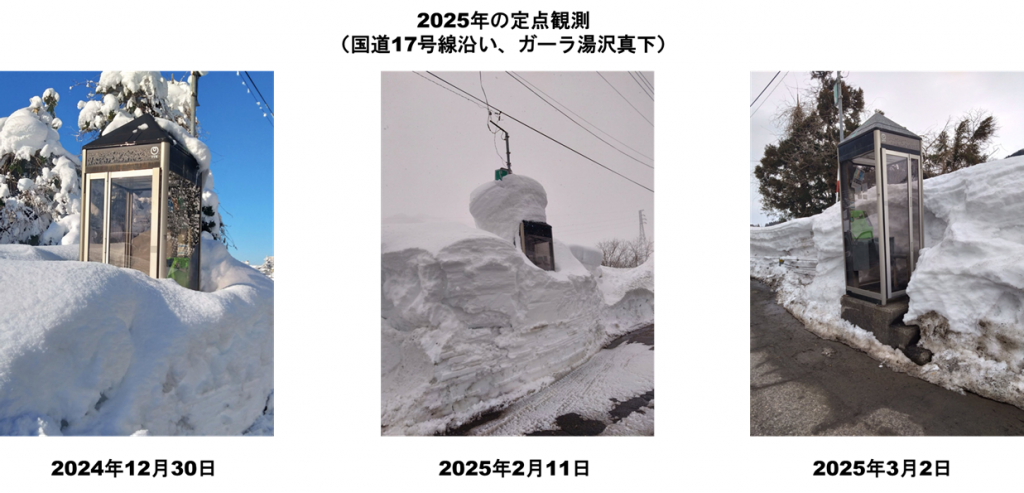
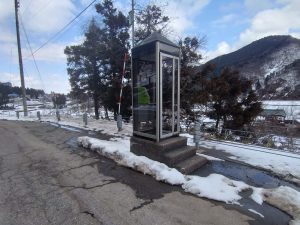
下の写真は2月初め、マンション駐車場に停めた愛車、たった一晩でこうなる。ドアを開けられるようになるまで、10分以上雪と格闘しなければならない。1週間外に停めっ放しの車は完全に雪の山に埋もれる。
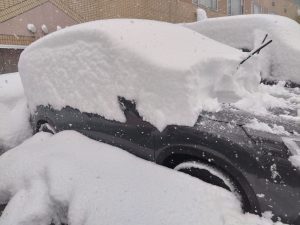
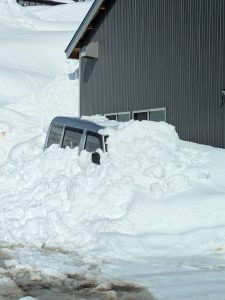
こうした豪雪は普段は起こらないような災難も巻き起こす。下の写真は拙宅マンションのスキーヤー用の出入り口、14階建ての屋上から落下した雪塊が渡り廊下の強化ガラスを一瞬にして粉砕する事故が2/14に発生、さらに翌日にも2段目の雪が落下。マンション建屋前の駐車場も閉鎖された。ちなみに添付した動画はフジTVのニュース「豪雪が招いた災害」特集で使われた。
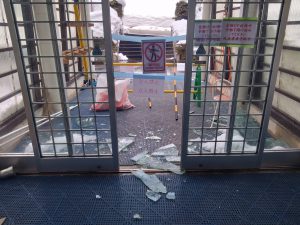

マンションの屋上にはこうした事故を予防するために融雪用のヒーターが備え付けられているが、今シーズンは想定を上回る積雪のために融雪が間に合わず事故になった。動画でわかるように事故後も真上の屋上からは雪庇がせり出しており、いつまた事故になるのかわからない。しかし屋上は雪に埋もれて階下からのドアも開けることができず(あまりにお粗末・・・)、抜本的な解決策と修繕は雪がすべて溶けるまで待つしかない。
また豪雪はほんの少し気温が緩むと多くのスキー場で雪崩を巻き起こし、さらに国道でも多くの被害が出た。2月8日の大雪では関越自動車道と並行する国道17号の両方で通行止めとなり、車両の立ち往生が発生、こうしたなかで国道17号の三国峠で雪崩が発生、真下にいた車を雪の塊が襲い車をガードレールに叩きつけて車は深い雪の中に埋まった。この時には近くで立ち往生していた車の運転手が大勢集まり、雪の中から車を掘り出し車内の家族4名を救出したが、長く越後湯沢に通ってこんな事故は初めて。
国道353号線は湯沢側から山を越えて日本随一の豪雪地帯津南町につながる。ここでは計3度雪崩のために通行止めになっている。下の写真は2度目の雪崩の翌週、通行止めが解除された直後の様子。そこら中に“雪崩の巣”が残っており、場所ごとに重機を使って雪下ろしをしているものの焼け石に水。果たしてこの翌週に3度目の雪崩が起こって三度めの通行止めになった。
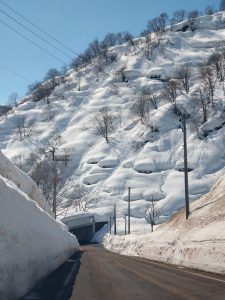
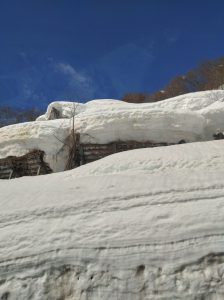
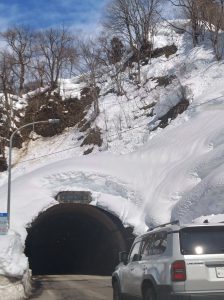
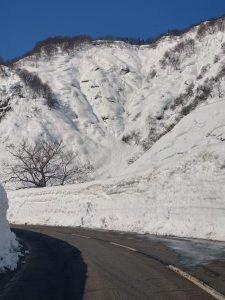
『雪友達』がたくさんできたよ
今シーズンのスキーライフで特筆すべきは、これまでは一人で滑ることばかりだった湯沢エリアで『雪友達』がたくさんできたこと。まずは自分のリゾートマンションで出会ったオーストラリア人夫妻MとD。聞けば今シーズンの初めにマンションの1室を購入し、これから(日本での)毎冬シーズン3か月間マンションに滞在してスノーボードに明け暮れるという。すでに若い時からのビジネスに成功してセミリタイア、(日本の)冬は湯沢地域でスノーボード三昧、残りの季節はシドニー近辺でサーフィン生活という、何とも羨ましいライフスタイル。以前の記事(『凍りついた市場は動き出すのか(リンク)』でも書いたが、昨年7月から宅建業法が改正されてこれまでよりも頻繁にリゾートマンションの売買が実現するようになった。もちろんインバウンド客の一部も強い関心を持っている。毎年日本の冬に来日して多大な宿泊料を毎回払っているクラスなら、たかだか十万円単位の価格でマンションの一部屋が手に入るならこんな夢のような話はないだろう。しかしこれまでは外国人にとって、管理費などを引き落とせる国内銀行口座(口座開設には国内の住民登録が必要)がマンション購入のネックになっていた。しかし今ではこうした外国人購入者に対して事務サービスなどのサポートを行う日本トレーディング国際合同会社(https://nippontradings.com/、英語名:Nippon Tradings International)という会社も現れた。湯沢地域の他のリゾートマンションを購入した数名の外国人に聞いたところ、いずれもこの会社を利用していた。おそらく潤沢に有り余っている湯沢地域のリゾートマンションへの外国人への扉は開かれたと見るべきで、今後はさらに多くの外国人が湯沢のリゾートマンションの購入に動くのではないか。MとDはそのパイオニアのように見える。
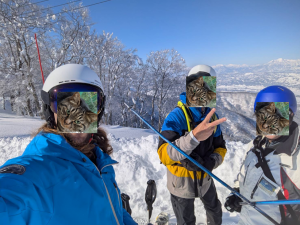
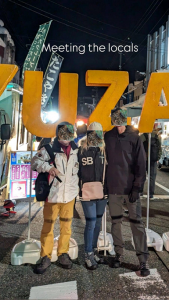
Mは愉快な奴で、野沢温泉に滑りに行った時に「毛無山とは毛が無い山、Without hair mountainの意味なんだぞ」と教えたら、嬉々としてこんな写真まで撮らせてくれた。周囲の日本人に大うけ!
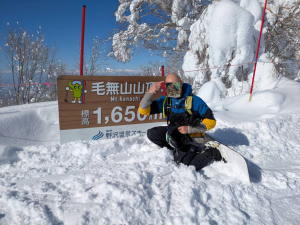
また最近になって知り合ったアメリカ人のDと彼女のI、東京で自分と同じ鉄道路線に住んでいる彼らもスキー、スノボのファンで、今シーズンから自分のマンションに泊りに来るようになった。下の写真はそのD君。人が触れるところまで雪に埋まった野沢温泉の交通案内板の前でジャンプしてくれた。ちなみにこの案内板はあまりに有名になったために、各地からスキー、スノボ客が押し寄せてステッカーを貼りだしたために、この日の翌週にはロープが張られて立ち入り禁止になってしまった。
彼ら、新しい“雪友達”とは来シーズンも共に遊びまくる予定で、楽しみにしている。
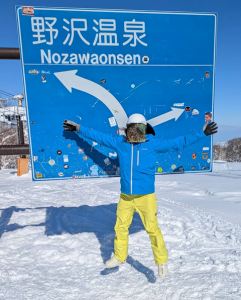
下の動画は野沢温泉スキー場のパラダイスゲレンデ。緩斜面だけど最高の眺望の中で気持ちよく滑れる。でもこのゲレンデの下に、スキー場随一の厳しいコースも。
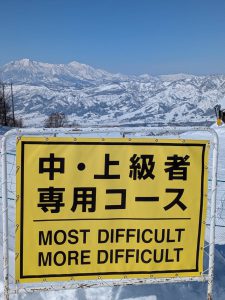
著しいインバウンドの影響:リフト料金の高騰と「夕食難民」
自分が越後湯沢地域でホームゲレンデにしているのが「かぐらみつまたスキー場」、越後湯沢駅から三国峠を車で15分ほど登ったところから展開する、みつまた、かぐら、田代の3つのゲレンデを一気に楽しめる広大なゲレンデ、最高標高は1,800mを超え地域のスキー場では最高の雪質が楽しめる。バックカントリーの名所としても有名なサイト。2001年からは苗場スキー場とも国内最長のロープウエイ、ドラゴンドラでつながり(別途追加料金あり)三国峠の新潟サイドいっぱいに広がる、地域でも一番の広大なスキー場になっている。
同スキー場はこれまで西武グループのプリンスホテルが運営してきたが、2022年9月にシンガポール政府の投資ファンドGICに譲渡された。すなわち今シーズンは買収後の2回目のシーズンにあたるわけだが、きわめて大きな変化がこの間に起きている。まず大きいのがリフト料金の値上がり、GICの買収前には4,000円だったリフト1日券(みつまた、かぐら、田代共通)が、毎年値上がりし今シーズンは7,200円に。おそらく来シーズンは7,800円になっているんじゃないか。さらにシニア割(55歳以上)や各種割引、午前券(8:00~13:00)まで廃止された。朝一番のパウダースノーを味わいに来る通のスキーヤーは、否応なしに1日券を買わされることになる。これほどの値上げを行ったのなら、新しい設備投資を行い施設をさらに楽しいものにするのかと思いきや、新規投資はまったくしている気配がなく、故障した機器はそのまま、ひどかったのは夏季に猛暑の中で行われた子供のサマークラスの会場でエアコンが故障したにも関わらず、現場の係員は「修繕の予算が下りない」を理由にその夏いっぱいエアコン無しで施設の影響を続けたそうだ。いったいGICはどういった経営戦略でこの施設を買収したのか、資産運用者の立場からGICの担当者に問い詰めてみたい。もちろんGIC買収以前の同スキー場のリフト券は今から考えると異様に安かった。この広大で最高の雪質を持つこのスキー場の真価が反映されていなかったと言っていいだろう。GICとしてはこうした“隠れた資産価値”を入手するために同スキー場の買収に踏み切ったのだろうが、《割安に放置された資産に資本を投じたうえで、独自の資本投下と経営戦略で将来の成長モデルを実現させる》という本来の投資の神髄を考えずに、ただイナゴのように短期的なリターンだけを貪って去っていくようではこの買収は“侵略”にしか見えてこない。近い将来に目標リターンを享受したGICが安易に他の投資グループにスキー場を転売しないことを望む。
実はかぐらスキー場の値上げは同スキー場だけでなく、地域全体のスキー場全体の値上げにつながっている。かぐらの値上げを見て、これまで長い間安定していた主なスキー場のリフト券が軒並み値上がりしている。もちろん海外の主要なスキー場のリフト券は円安の効果もあって円換算すると2万円/日前後のものが多いので、インバウンド客にとってはいまだに実にお得な価格には違いない。しかし30年も所得が増加しない国のスキーヤーにとっては、リフト券ばかりが“グローバル化”する動きはたまらない。
現在、特に新型コロナ以降の湯沢はインバウンド客で溢れている。湯沢の場合その多くが台湾人で、オーストラリア人で溢れるニセコや白馬、野沢温泉とは少し趣が異なる。パンデミックの前から湯沢町挙げての台湾向けキャンペーンが奏功したことに加え、湯沢を訪問した台湾人のインフルエンサーがこぞって湯沢のスキー場と温泉の楽しさを発信していることもあり、外国人が多い宿泊施設は宿泊客のほとんどが台湾人という景色となっている。その恩恵もあり湯沢町内の観光関連施設、特に飲食店は週末だけでなく、ウイークデイも観光客で溢れている。今年になって湯沢でトレンドワードになっているのが「夕食難民」。湯沢には数十年にわたって営まれている民宿が多く、こうした宿泊施設では経営者の高齢化もあって「素泊まり」が基本になりつつある。もちろん湯沢の温泉街には数多くの飲食店、居酒屋が並んでいるが、今年はそのキャパシティをはるかに超えて、平日の夜でもどこにも空きがない状態、予約を取るにも数週間先でないと空きがない。仕方ないのでコンビニで買って済まそうとしても駅裏のセブンイレブンはレジを待つ100人以上の行列が店内の売り場を1周する形で並んでいる。湯沢に通って20年以上になるが、こんな光景は見たことが無い。
思えばニセコや白馬、野沢高原などのスキーリゾートはバブル崩壊とスキー人口の激減によって1990年代以降に壊滅的な危機を迎え、ここにオーストラリアなどの外国資本が入り込んでやがて日本の中の異世界を形成していった。それに比べれば湯沢は温泉もあるし、新幹線で東京から70分程度、何といってもバブル時代にニョキニョキと建設されたリゾートマンションからの税収入などで、本格的な危機状況には陥ることなく“ぬるま湯の中”でここまで来た。地元の業者が数多く残ったのはいいことかも知れないが、高齢になった老舗の店主はいまだにバブル気取りで客をあしらう。タクシー会社に至っては電話で車を呼んでも「いつになるか分かんないっすよ!」と捨て台詞を吐く輩もいる。こうした風潮の中で町を挙げてスキー客を歓待していた「湯沢ゆきまつり」などのイベントも関係者が高齢化する中でいつの間にか衰退していった。今また台湾を始めとするインバウンド客が押し寄せてくれば、「どうせ何もしなくても客は自然にやってくる」とばかりに営業努力をさらに怠るようになることを真剣に憂慮する。
先に描いたGICのように“イナゴの如き”外国資本は有害だが、改革努力に目を向けない地元の高齢経営者ばかりでも湯沢の将来は開けない。今の湯沢に必要なのは、地元の伝統的な経営者とは違う価値観を持ち、本格的に地域に根を下ろして事業を営む資本家だろう。こうした資本家が外国から現れるのを待つのか、あるいは自分で始めるか―いや、資本はないんだけどね
A Once-in-20-Years Heavy Snowfall: Scenes Long Forgotten Come Back to Life
The winter of 2024–25 turned out to be a record-breaking snow season. Even in Niigata City, where snowfall is typically light, the heaviest snow in recorded history was observed, causing major disruptions to both roads and railway lines. Naturally, the heavy snowfall also wreaked havoc on the ski resort areas centered around Echigo-Yuzawa. At many resorts, ski lifts were buried under the snow, forcing operations to be suspended.
It’s been nearly 20 years since ski resorts last had to shut down not due to a lack of snow, but because of too much of it—something I can hardly recall happening in recent memory.
I actually have a personal benchmark I visit every year to gauge snowfall: a public phone booth located directly under Gala Yuzawa Station, near the northern edge of Yuzawa Town along Route 17. Over 20 years ago, I remember this phone booth being completely buried in snow during the coldest part of winter.
In the past two decades, I hadn’t seen that sight again—until this season. During the cold wave in February, the booth was almost entirely buried once more. While the snow began to melt in early March, an unusually late cold snap in mid-March covered it again. The photo below, taken in early March last year, makes the difference in snow volume strikingly clear.
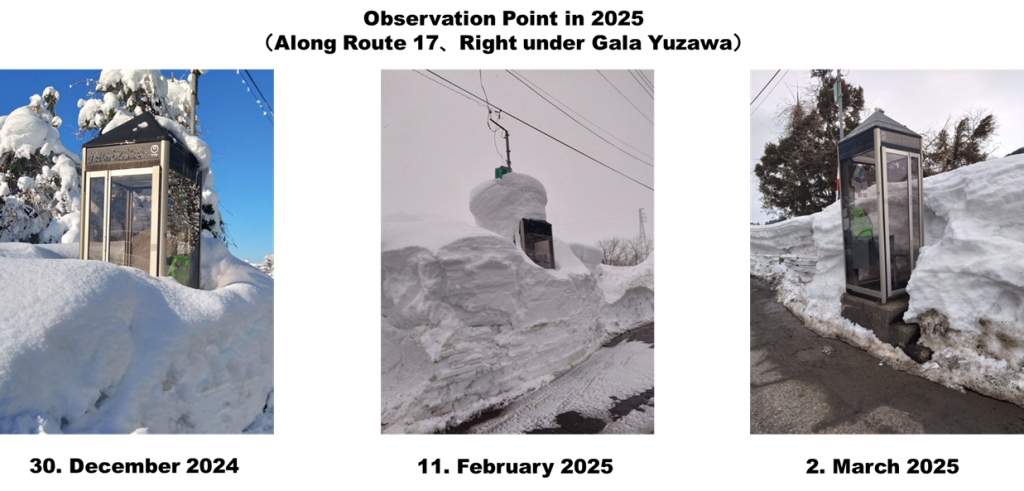

The photo below was taken in early February. I had parked my car in the apartment parking lot, and this is what it looked like after just one night.
It took over 10 minutes of battling the snow just to be able to open the door.
Cars left outside for a week end up completely buried under a mountain of snow.


Such heavy snowfall can also lead to unexpected disasters.
The photo below shows the skier’s entrance at my apartment building. On February 14, a large mass of snow fell from the roof of the 14-story building, instantly shattering the reinforced glass of the connecting walkway.
The second layer of snow fell the following day, and the parking area in front of the building had to be closed.
Incidentally, the attached video was featured in a Fuji TV news segment titled “Disasters Brought by Heavy Snow.”


The rooftop of the apartment building is equipped with snow-melting heaters designed to prevent such accidents. However, this season’s snowfall far exceeded expectations, and the heaters couldn’t keep up — resulting in the incident.
As you can see in the video, even after the accident, overhanging snow cornices remained on the rooftop directly above, leaving us unsure when another collapse might occur. To make matters worse, the rooftop was so buried in snow that the access door from the lower floors couldn’t even be opened (which is rather ridiculous…), so any fundamental repairs or preventative measures will have to wait until the snow completely melts.
What’s more, just a slight rise in temperature during this heavy snow season has triggered avalanches at many ski resorts, as well as significant damage along national highways. On February 8, heavy snowfall forced both the Kanetsu Expressway and the parallel Route 17 to close, causing traffic standstills. Amidst this chaos, an avalanche struck the Mikuni Pass area of Route 17, burying a car under a massive block of snow and slamming it into the guardrail. The car ended up completely buried in deep snow.
Fortunately, drivers who had been stranded nearby rushed to the scene, dug out the vehicle, and rescued the four family members trapped inside. I’ve been coming to Echigo-Yuzawa for years, and I’ve never witnessed anything like this.
National Route 353 connects Yuzawa to Tsunan Town — one of the snowiest areas in Japan — over the mountains. This road has been closed three times this season due to avalanches. The photo below was taken the week after the second avalanche, just as the road reopened. Avalanche-prone areas were visible everywhere, and although snow-clearing work with heavy machinery was ongoing, it felt like a losing battle. And indeed, just one week later, a third avalanche occurred, leading to yet another closure.




I’ve Made So Many ‘Snow Friends’!
One highlight of this ski season has been making lots of new “snow friends” in the Yuzawa area, where I used to ski mostly alone.
First and foremost are M and D, an Australian couple I met at my resort condo. They told me they bought a unit at the start of this season and plan to spend three months here every winter from now on, dedicating their time to snowboarding. Having already found success in business at a young age, they’ve semi-retired and now enjoy an enviable lifestyle — snowboarding all winter in Yuzawa and surfing near Sydney for the rest of the year.
As I mentioned in a previous article (“Will the Frozen Market Start Moving Again?”), Japan’s Real Estate Transaction Law was revised in July last year, making resort condo transactions easier and more frequent. Naturally, some inbound visitors have shown strong interest as well.
For those who come to Japan every winter and pay hefty hotel fees each time, the idea of owning a condo unit for just a few thousand dollars must sound like a dream come true. However, until recently, the biggest obstacle for foreign buyers was the need for a domestic bank account (which requires a Japanese residence registration) to pay monthly management fees and other costs.
Now, though, there’s a company called Nippon Tradings International that offers support services for foreign buyers, helping them navigate such hurdles. Several foreigners I spoke with who had purchased resort condos in the Yuzawa area all used this company.
It seems safe to say that the doors have finally opened for foreign ownership in Yuzawa’s abundant resort condo market — and M and D appear to be pioneers of this new trend.


M is a funny guy. When we went skiing in Nozawa Onsen, I told him that ‘Kenashi-yama’ means ‘a mountain without hair’—literally ‘Without Hair Mountain.’ He was so delighted he even posed for a photo like this. The Japanese people around us thought it was hilarious! Mt. Kenashi and Mr. Kenashi!

More recently, I got to know an American couple, D and his girlfriend I, who live along the same train line as I do in Tokyo. They’re also big fans of skiing and snowboarding, and starting this season, they’ve begun staying at my condo when they head to the slopes. The photo below is of D, jumping in front of a snow-covered traffic sign in Nozawa Onsen—so buried that people could actually touch the top of it. Incidentally, that sign became so famous that skiers and snowboarders from all over started flocking to it and plastering it with stickers. Just a week after we took this photo, the area was roped off and access was prohibited.

We’re already planning to hang out a ton with our new ‘snow friends’ next season too—I’m really looking forward to it.
The video below is from the Paradise slope at Nozawa Onsen Ski Resort. It’s a gentle slope, but the view is absolutely amazing and it feels great to cruise down it. That said, just below this slope lies one of the steepest, most challenging runs in the whole resort.

The Impact of the Inbound Boom: Soaring Lift Ticket Prices and the Rise of “Dinner Refugees”
My home ski resort in the Echigo-Yuzawa area is Kagura Mitsumata Ski Resort. Located about 15 minutes by car from Echigo-Yuzawa Station over the Mikuni Pass, this vast resort offers access to three connected areas—Mitsumata, Kagura, and Tashiro—all in one. With a peak elevation of over 1,800 meters, it boasts the best snow quality in the region and is renowned as a backcountry paradise. Since 2001, it has also been connected to Naeba Ski Resort via the Dragondola, Japan’s longest ropeway (additional fee required), forming the largest ski area on the Niigata side of the Mikuni Pass.
Until recently, the resort was operated by the Seibu Group’s Prince Hotel, but in September 2022, it was sold to GIC, the Singaporean government’s sovereign wealth fund. This season marks the second winter since the acquisition, and major changes have already taken place.
The most obvious shift has been in lift ticket prices. Before GIC’s takeover, a 1day pass (valid for Mitsumata, Kagura, and Tashiro) cost ¥4,000. Since then, prices have increased annually, reaching ¥7,200 this season. I wouldn’t be surprised if it goes up to ¥7,800 next year. On top of that, all discounts—including senior discounts (for those 55+), various promotions, and even the popular morning pass (valid 8:00–13:00)—have been discontinued. Now, even seasoned skiers who only come for the early morning powder are forced to buy a full-day pass.
You might expect such a steep price hike to be accompanied by major investments in facilities or infrastructure—but that hasn’t happened. There are no visible upgrades, and even broken equipment has been left unfixed. One particularly shocking example: during the scorching summer, air conditioning at a children’s summer program venue broke down, and staff reportedly said, “We didn’t get budget approval for repairs,” so the program was held for the entire summer without air conditioning.
It makes me wonder—what was GIC’s strategy in acquiring this resort? As someone involved in asset management, I’d love to ask their reps directly. To be fair, Kagura’s previous ticket prices were arguably too cheap for a resort of this scale and snow quality. GIC likely saw this “undervalued asset” and acquired it with that in mind. But if their strategy is simply to chase short-term gains without meaningful reinvestment, it starts to feel less like investment and more like exploitation. I sincerely hope they don’t flip the resort to another investment firm after hitting their target returns.
Kagura’s price hikes have also triggered similar increases across other local resorts. Seeing Kagura raise its prices, other ski areas—which had kept prices stable for years—have followed suit. Of course, compared to major overseas ski resorts, where lift tickets often run close to ¥20,000 a day (especially with the weak yen), Japan still offers incredible value for inbound tourists. But for domestic skiers in a country where wages haven’t risen in 30 years, this kind of “globalization” of lift prices feels like a punch in the gut.
Since the COVID-19 pandemic, Yuzawa has seen a massive surge in inbound tourism. Unlike ski destinations such as Niseko, Hakuba, and Nozawa Onsen, which are overrun with Australians, Yuzawa’s influx is primarily from Taiwan. This is partly due to tourism campaigns targeted at Taiwan that the town of Yuzawa launched even before the pandemic, as well as Taiwanese influencers who have since visited and widely shared the appeal of Yuzawa’s ski resorts and hot springs. As a result, many accommodations that cater to foreign guests are now filled almost entirely with Taiwanese travelers.
Thanks to this, tourist-related businesses in Yuzawa—especially restaurants—are bustling not only on weekends but throughout the week. In fact, one of the trending terms in Yuzawa this year is “dinner refugees.” Many of the accommodations here are long-standing family-run inns that have been around for decades. With aging owners, many have transitioned to offering “room only” stays without meals. While Yuzawa’s hot spring district does have plenty of eateries and izakayas, this season they’ve been completely overwhelmed. Even on weekday evenings, it’s nearly impossible to get a seat without a reservation—some places are booked out weeks in advance. And when people give up and try to grab something from the local convenience store, they’re met with massive lines. At the 7-Eleven behind the station, over 100 people line up at the register, forming a queue that wraps around the entire store. I’ve been coming to Yuzawa for over 20 years, and I’ve never seen anything like this.
Looking back, ski resorts like Niseko, Hakuba, and Nozawa were hit hard in the 1990s after Japan’s economic bubble burst and the domestic skiing population plummeted. That opened the door for foreign capital—particularly from Australia—which eventually transformed those areas into ski resorts that feel like “different worlds within Japan.” In contrast, Yuzawa has hot springs, is only about 70 minutes from Tokyo via shinkansen, and has been cushioned by tax revenue from all the resort condos that popped up during the bubble era. As a result, Yuzawa has never faced a true crisis and has coasted along in a state of lukewarm comfort.
While it’s arguably a good thing that many local businesses have survived, there’s a downside too. Elderly shop owners, still stuck in a bubble-era mindset, often come off as arrogant or dismissive toward customers. One taxi company, when I called for a car, bluntly told me, “No idea when one’ll be available!”—and then just hung up. Community events like the “Yuzawa Snow Festival,” which once welcomed skiers town-wide, have quietly faded away as the organizers aged and no one stepped up to continue them.
Now, with a new wave of inbound visitors from Taiwan and elsewhere, I genuinely worry that the town will once again fall into complacency, thinking, “We don’t need to try—guests will come anyway.” That kind of thinking is dangerous.
Just like GIC—the foreign investor I wrote about earlier—“locust-like” capital that chases only short-term gains is harmful. But at the same time, a future built solely on aging local business owners who resist change won’t lead anywhere either. What Yuzawa really needs now are investors with fresh values, different from the traditional local mindset—people willing to truly put down roots and commit to the region. Whether such capital comes from abroad, or whether I should be the one to start something… Well, I don’t exactly have the capital myself, but still.
